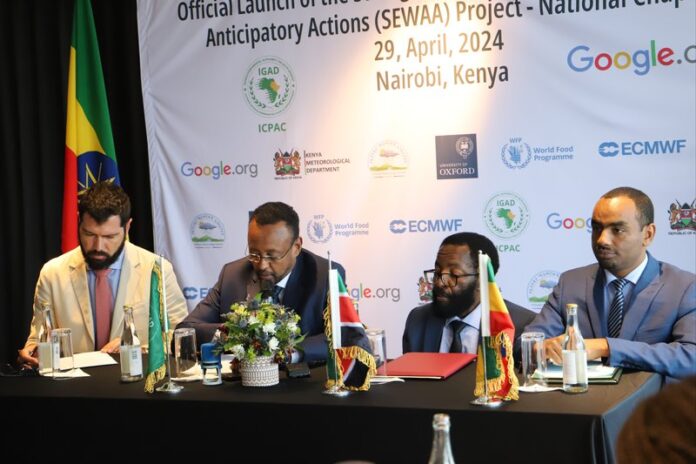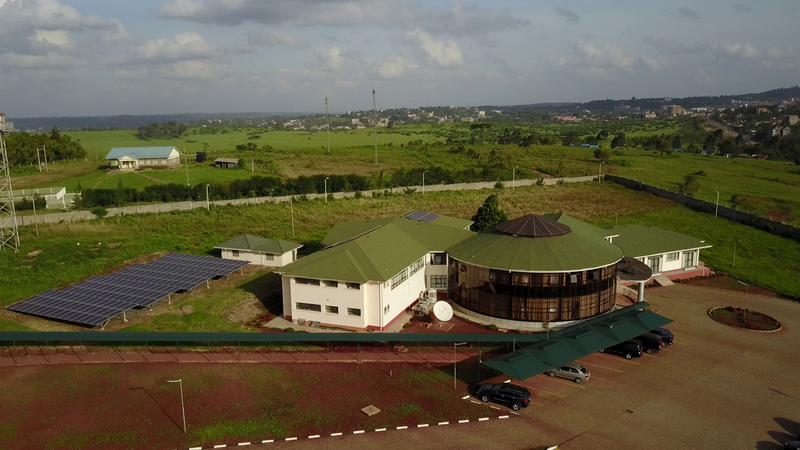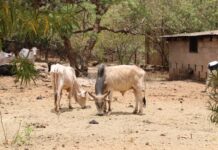
|
Getting your Trinity Audio player ready...
|
By Henry Owino
Nairobi, Kenya: As the rains continue pounding in Kenya and the East African region, the Intergovernmental Authority on Development (IGAD’s) Climate Prediction and Applications Centre (ICPAC), has received a major boost for its kitty in disaster preparedness and response capabilities. Funding comes from Google.org, the charitable arm of Google which is an American multinational technology company.
The funds have been made possible by United Nation’s World Food Programme (WFP) which played a pivotal role in negotiating for the coffers. The financial support is for the implementation of ICPAC pioneering project titled; Strengthening Early Warning Systems for Anticipatory Actions.
According to Pedro Mortara, Deputy Team Lead for Food Systems, Climate Action and Gender Equality for Eastern Africa, the funds are strictly for the project Strengthening Early Warning Systems for Anticipatory Actions (SEWAA).
The initiative is aimed at leveraging machine learning to enhance early warning information systems, marks a collaborative effort with some of leading weather and climate research institutions. For instance, University of Oxford, the European Centre for Medium-Range Weather Forecasts (ECMWF) and a humanitarian organization.

Mortara said the funding is provided by WFP, and will also benefit the Kenya Meteorological Department (KMD) and Ethiopian Meteorological Institute (EMI). It is for aiding in the enhancement of the institutions’ national and sub-national forecasts.
“By transforming the quality of early warning information available to communities in disaster-prone regions, the project endeavors to facilitate proactive responses to critical alerts,” Mortara said.
Dr Guleid Artan, Director, IGAD’s ICPAC stated given the exacerbation of natural hazard-induced disasters by climate change, the importance of timely and accurate early warning systems cannot be overstated. Supported by Google.org, this project endeavors to address this pressing need by harnessing cutting-edge technology and innovative approaches.
“Through the utilization of artificial intelligence, machine learning, and data analytics, the project aims to enhance the accuracy and timeliness of disaster alerts, empowering communities to take proactive measures to safeguard lives and livelihoods,” Artan explained.
Dr. Guleid Artan, Director at the IGAD Climate Prediction and Applications Centre, expressed enthusiasm for the collaboration, highlighting the combination of expertise in weather forecasting, disaster risk reduction, and technological capabilities.
Dr Artan noted “With the involvement of partners such as Google, the University of Oxford, the Ethiopian Meteorological Institute, the Kenya Meteorological Department, and the World Food Programme, the project aspires to revolutionize early warning systems in the IGAD region and enable communities to prepare and act preemptively against impending hazards”.
He however said initially, the project will focus on pilot implementations in Ethiopia and Kenya, with the lessons learned informing the scaling-up of initiatives across the region. Ultimately, the goal is to ensure that vulnerable communities throughout the IGAD region have access to life-saving early warning information and that they can take timely action in the face of impending disasters.
According to Dr. Asaminew Teshome, Deputy at the Ethiopian Metrology Institute (EMI), said that Ethiopia has got a good number of stations automated with radar that provide global information to the country. He said it has enabled Ethiopians to prepare ahead of time and avert several risks associated with harsh weather.
“In Ethiopia, the rains are pounding just like in Kenya right now, however, we have not experience serious casualties or life losses and damages. From media reports, Kenya situation is frightening and it needs urgent intervention hence the initiative for early warnings for disaster preparedness,” Dr Teshome observed.
While Dr. David Gikungu, Director at the Kenya Meteorological Department (KMD) and the current Permanent Representative of Kenya with the World Meteorological Organization (WMO) said as an organization, they are responsible for weather forecast research and feeding the government and citizens with information. However, he clarified how that information is used, is the individuals or communities and country’s leadership responsibility.
“We always give out the early warnings for disaster preparedness to government and put the data on KMD website with frequent updates. Even the information for the current pounding heavy rains in April and May in Kenya were released in time,” Dr. Gikungu said.
“Our role ends after disseminating information on weather forecast to the pu. The choice and use of the information depends on the recipients,” he added
While speaking on a local media station on Monday 29, Dr. Isaac Mwaura, Kenya Government Spokesperson said up to 169 people have lost their lives since onset of heavy rains. Over 100 people rescued and hospitalized. For urgent and emergency assistance Kenya citizens can now call a national toll free number at 0800721571 while residents in Nairobi can call 1508 while Government Spokesperson’s Office is opened to the public any time.
On the other hand, Philip Omondi, Senior Climate Change Scientist at ICPAC, cautioned that the heavy rains are likely to continue up to next few weeks in the month of May. He disclosed forecast is done on a weekly basis, within 10 days, monthly and seasonal with updates on their website.
The weatherman predicts more rains are likely to be experienced in the month of May. So, the government must work extra hard in order to ensure lives are safe if the pounding rains get out of hand.













